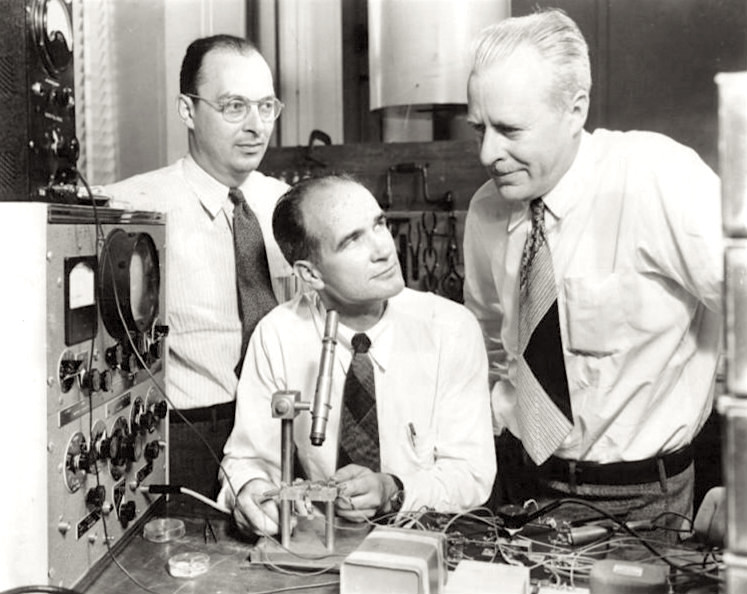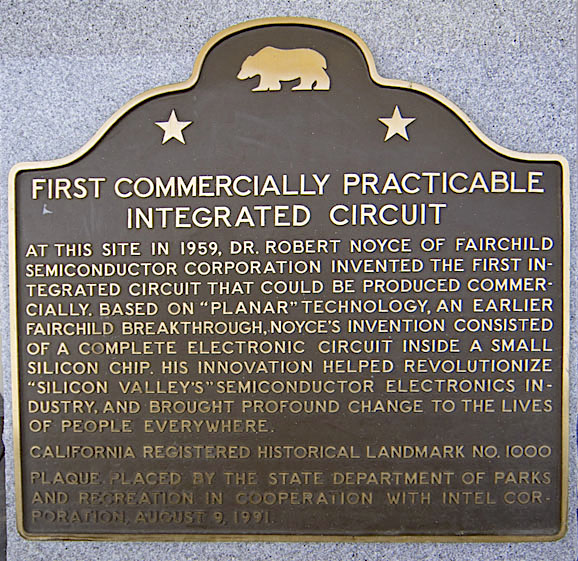Successful startups often emphasize their grassroots aspects. In part one of this series, we talked about the origins of startup culture and the DIY attitude that is prevalent in the tech industry. However, there’s more to modern startup culture than that. Today, it is in many ways defined by the innovation infrastructure that got things started and allowed the tech space to blossom, and that is the focus of this article.

Bardeen, Shockley and Brattain at Bell Labs in 1948 год | AT&T | PD
The industrialization of the Bay Area was slow and messy. For most of the 20th century, it was neither the rural paradise people like to imagine nor the capital of the tech scene. By the time Hewlett Packard (HP) came about in 1937, California was already home to a decent number of aviation and telecom companies.
However, the state was still plagued by brain drain.
During WW2, most tech businesses had to abandon their own plans, which at the time revolved around semiconductor and microwave research, to develop what the military told them to. It might seem strange, but what initially looked like a setback at the time proved to be of great help later on.
 A reflex klystron (1953) | Erbade | CC BY-SA 3.0
A reflex klystron (1953) | Erbade | CC BY-SA 3.0
For the next years, the federal government became an important source of capital for the country’s recovering tech segment. Venture capital didn’t yet exist, so securing funding was no easy feat for tech startups. However, the government, riding the wave of the postwar economic boom, could afford to take risks. Over the course of the Cold War, this not only propelled Silicon Valley into existence, but also made this industry prestigious.
Long before the WW2, Frederick Terman — the renowned engineer and the person credited with motivating HP to do business in Silicon Valley — had been unhappy with the brain drain at Stanford. Something had to be done to stop graduates leaving the Valley and, at the same time, to breathe life into the Bay Area. It’s important to understand that at that time, Stanford University wasn’t as renowned as it is today. It simply wasn’t in the same league as Harvard or Yale. So, the task he undertook was highly ambitious.

Philip Odegard | CC BY-ND
Over time, Terman achieved everything he hoped to. As a result of his actions, the University became firmly embedded in the state’s economy. It provided valuable resources and investor connections to its students. The AI lab, established in 1963, is to this day credited with nurturing the best talent in the Valley. Stanford essentially became Silicon Valley’s first startup incubator.
As tech investments were risky, the pool of sources was shallow: pension funds were barred from high-risk investments by law, few wealthy individuals knew enough about startups to go for it, and there wasn’t much in between. The thing that accelerated the growth of the tech industry was the rise of private capital.
HP’s 1957 IPO brought attention to the Valley. At the same time, the Small Business Investment Company Act (SBIC) came into force, encouraging financial institutions to invest in higher-risk enterprises. By 1968, SBIC funds accounted for 75% of all American venture capital.
Another success story of Silicon Valley was that of Fairchild Semiconductor, founded in 1957. Prior to this, William Shockley, the Nobel Prize–winning inventor of the transistor, established Shockley Semiconductor Laboratory to manufacture silicon transistors, ultimately giving the valley its name.
Shockley was born in the Bay Area, rose to fame working for Bell Labs on the East Coast, and moved back home to take care of his mom. For his new venture, Shockley recruited a number of young talented PhD graduates. However, his management style was described as aggressive, so less than a year later, eight of the most prominent engineers left after securing outside funding to found Fairchild Semiconductor.

The historic marker at the Fairchild building | Hoenny | СС0
Shockley himself faded into obscurity, alienating the public with his outrageous statements on race and eugenics, while those he called the “traitorous eight” found tremendous success. The companies that spurted out of the Fairchild venture, embodied the new, liberal approach to management opposed to Shockley’s legacy.
Companies such as Apple and Microsoft are often viewed as the fathers of the modern startup culture. However, they themselves were indebted to the pioneers of the 1950s and the 1960s, which they heavily benefitted from, together with the regulation put in place to advance in the Cold War.
The reforms necessary to bring capital into the Valley were mostly politically motivated, while innovation was encouraged as a matter of national importance. This mindset remains today, where even though the Cold War has ended, countries still compete for the best startup infrastructure. For instance, the Internet would not have been impossible without its military predecessor: the ARPANET. Also, the American microcomputers of the 1980s would have been much harder to manufacture if not for the tariffs placed on Japanese transistors.
All around the world, academic institutions strive to replicate the success of Stanford’s innovation infrastructure, while it itself remains the proverbial heart of the Valley. Steve Wozniak’s Homebrew Computer Club held regular meetings at Stanford’s facilities, and wouldn’t have been such a success without the University’s help. Steve Jobs and countless other tech founders, dropouts and alumni alike, made life-changing connections at their unis.

Bardeen, Shockley and Brattain at Bell Labs in 1948 год | AT&T | PD
Victory at All Costs
The industrialization of the Bay Area was slow and messy. For most of the 20th century, it was neither the rural paradise people like to imagine nor the capital of the tech scene. By the time Hewlett Packard (HP) came about in 1937, California was already home to a decent number of aviation and telecom companies.
However, the state was still plagued by brain drain.
During WW2, most tech businesses had to abandon their own plans, which at the time revolved around semiconductor and microwave research, to develop what the military told them to. It might seem strange, but what initially looked like a setback at the time proved to be of great help later on.
Radar and jamming systems, manufactured by the likes of HP, played a strategic role during the war. Diplomatic tensions in the early 1950s reinforced the idea of building a successful tech industry out of the alliances that tech companies had forged working for the military.
 A reflex klystron (1953) | Erbade | CC BY-SA 3.0
A reflex klystron (1953) | Erbade | CC BY-SA 3.0For the next years, the federal government became an important source of capital for the country’s recovering tech segment. Venture capital didn’t yet exist, so securing funding was no easy feat for tech startups. However, the government, riding the wave of the postwar economic boom, could afford to take risks. Over the course of the Cold War, this not only propelled Silicon Valley into existence, but also made this industry prestigious.
The Original Incubator
Long before the WW2, Frederick Terman — the renowned engineer and the person credited with motivating HP to do business in Silicon Valley — had been unhappy with the brain drain at Stanford. Something had to be done to stop graduates leaving the Valley and, at the same time, to breathe life into the Bay Area. It’s important to understand that at that time, Stanford University wasn’t as renowned as it is today. It simply wasn’t in the same league as Harvard or Yale. So, the task he undertook was highly ambitious.
Terman firmly believed that the University had to give back to the community it was established in. It couldn’t function in isolation. So he decided to turn Stanford into a platform that would accelerate innovation in the Valley. This was achieved through the ever-growing number of labs, led by prominent scientists, and institutional assistance to would-be inventors.

Philip Odegard | CC BY-ND
Over time, Terman achieved everything he hoped to. As a result of his actions, the University became firmly embedded in the state’s economy. It provided valuable resources and investor connections to its students. The AI lab, established in 1963, is to this day credited with nurturing the best talent in the Valley. Stanford essentially became Silicon Valley’s first startup incubator.
The West Coast Guide to Business
As tech investments were risky, the pool of sources was shallow: pension funds were barred from high-risk investments by law, few wealthy individuals knew enough about startups to go for it, and there wasn’t much in between. The thing that accelerated the growth of the tech industry was the rise of private capital.
HP’s 1957 IPO brought attention to the Valley. At the same time, the Small Business Investment Company Act (SBIC) came into force, encouraging financial institutions to invest in higher-risk enterprises. By 1968, SBIC funds accounted for 75% of all American venture capital.
Another success story of Silicon Valley was that of Fairchild Semiconductor, founded in 1957. Prior to this, William Shockley, the Nobel Prize–winning inventor of the transistor, established Shockley Semiconductor Laboratory to manufacture silicon transistors, ultimately giving the valley its name.
Shockley was born in the Bay Area, rose to fame working for Bell Labs on the East Coast, and moved back home to take care of his mom. For his new venture, Shockley recruited a number of young talented PhD graduates. However, his management style was described as aggressive, so less than a year later, eight of the most prominent engineers left after securing outside funding to found Fairchild Semiconductor.

The historic marker at the Fairchild building | Hoenny | СС0
Shockley himself faded into obscurity, alienating the public with his outrageous statements on race and eugenics, while those he called the “traitorous eight” found tremendous success. The companies that spurted out of the Fairchild venture, embodied the new, liberal approach to management opposed to Shockley’s legacy.
Right Place, Right Time
Companies such as Apple and Microsoft are often viewed as the fathers of the modern startup culture. However, they themselves were indebted to the pioneers of the 1950s and the 1960s, which they heavily benefitted from, together with the regulation put in place to advance in the Cold War.
The reforms necessary to bring capital into the Valley were mostly politically motivated, while innovation was encouraged as a matter of national importance. This mindset remains today, where even though the Cold War has ended, countries still compete for the best startup infrastructure. For instance, the Internet would not have been impossible without its military predecessor: the ARPANET. Also, the American microcomputers of the 1980s would have been much harder to manufacture if not for the tariffs placed on Japanese transistors.
All around the world, academic institutions strive to replicate the success of Stanford’s innovation infrastructure, while it itself remains the proverbial heart of the Valley. Steve Wozniak’s Homebrew Computer Club held regular meetings at Stanford’s facilities, and wouldn’t have been such a success without the University’s help. Steve Jobs and countless other tech founders, dropouts and alumni alike, made life-changing connections at their unis.
About the author:
Dmitry works with tech brands to create all types of content and promote corporate culture at scale. He is acting as an advisor for both the SXSW Pitch & SXSW Release IT event (since 2017), and a Techstars Startup Digest curator (since 2013). Email: dmitry.kabanov [@] startupdigestmail.com
Meet A Content Strategist: An Interview with Techstars Curator & SXSW Advisor
The Game of Archetypes: How Storytelling Works for Tech Brands
How Brands Can Break Through the Tech Media Bubble
